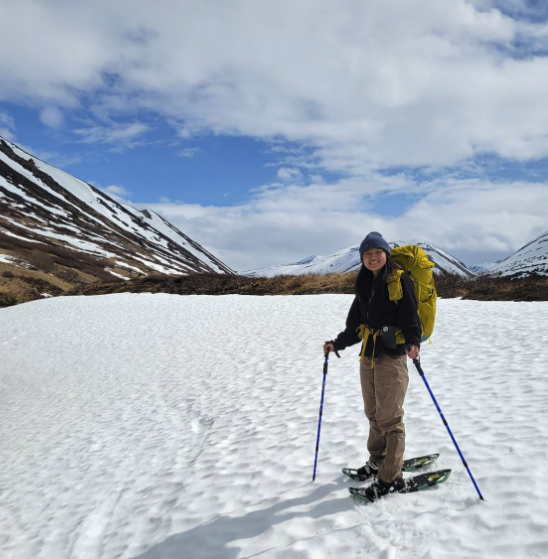ACEP interns analyze potential transmission line paths across the Arctic
August 24, 2023

Lilian Zhu backpacks the Resurrection Pass Trail through the Kenai Mountains mid May. She is ecstatic to have finally found a patch of snow she won’t sink under, even with snowshoes on.
This article is part of a series highlighting ACEP’s 2023 cohort of eighteen undergraduate interns. To read about other projects and learn more about the program, please visit the ACEP Internship Program website.
This summer, ACEP interns Lilian Zhu and Lauren Bryan learned and applied data visualization and cloud computing skills under the mentorship of Erin Trochim on the Arctic Energy Atlas project.
The project aims to find cost-efficient paths for energy grid expansion in key locations across the Arctic as many Arctic communities face high costs due to the large distances between resources and demand. The project team integrates various public datasets in order to find the least-cost paths for transmission lines. This approach creates a simple and transparent method for estimating costs, which enables consistent price comparisons for streamlined grid development. This work helps to improve communities’ access to energy and supports sustainable energy development.
As ACEP’s intern, Zhu worked on developing a Python-based transmission line cost calculator. This calculator will use Google-Earth-Engine produced geospatial data and disseminates the results for public use. Zhu also advanced her skills in understanding and analyzing geospatial data, harnessing her previous coding and GIS experience.
Bryan’s time on the project focused on refining and visualizing data, using primarily Google Earth Engine and QGIS programs. Through her internship, she expanded her knowledge of GIS and took a deeper look into the political context of Arctic energy issues.
“It’s been challenging, but there’s no better time to learn these things than now, and I know I’ll be able to apply them wherever I am,” Bryan said,
Interest in projects of this nature is growing: as investments into national security infrastructure and critical minerals expand across the Pan-Arctic, funding can be harnessed for energy programs that will benefit remote communities. A multitude of social and physical factors must be taken into account when planning for grid interconnections. Zhu and Bryan examined these factors at both a Pan-Arctic and Alaskan scale, with the future of the project looking to short- and long-distance interconnection case studies.

Lauren Bryan worked on data visualization and cloud computing skills as an ACEP intern this summer.
A sophomore at Harvey Mudd College in Claremont, California, studying mathematics and computer science, Zhu came to Alaska, eager to apply mathematical and computation skills to the distinct infrastructure challenges across the diverse landscape. The unique nature of the Arctic has inspired her to pursue further studies of the polar environments analytically as well as in fieldwork.
A senior at Hope College in Holland, Michigan, majoring in environmental science, Bryan has previously done research on the chemical composition of northern peat bogs. She looks forward to applying her newly honed geospatial data skills to climate issues.
These internships were funded by the Denali Commission and National Science Foundation through the ACEP Undergraduate Summer Internship and National Science Foundation Research Experiences for Undergraduates programs. View the final presentation for this project on ACEP’s YouTube Channel. For more information on this project, please contact Erin Trochim at edtrochim@alaska.edu.


